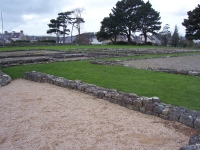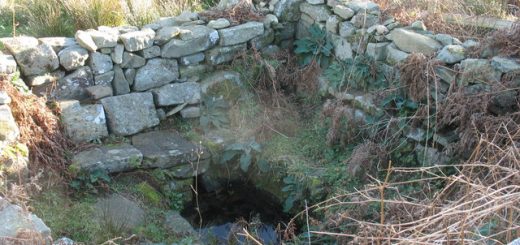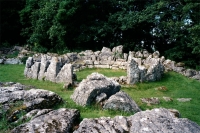Maiden Castle
This is the largest Iron Age Hillfort in Britain, consisting of a spectacular series of bank and ditch defences enclosing an area of 45 acres. These fortifications cover the much earlier site of a Middle Neolithic Causeway Camp from around 3000BC. The camp was enclosed by two lines of ditches, the remains of which are indistinguishable. Traces remain of a Bank Barrow from this period, which was originally almost 550 feet in length.
 During the Iron Age the site was fortified in a number of stages the first around 700BC when part of the Eastern end of the existing hill was enclosed with a single rampart. Three hundred years later around 400BC the ditch and rampart was extended to enclose the whole of the hillfort. The outer banks and ditches were added around 100BC. Wooden ramparts would have further protected the site and its scale must have made it an imposing site for attackers. This long period of development was by no means unbroken, the hill fort being deserted for long intervals.
During the Iron Age the site was fortified in a number of stages the first around 700BC when part of the Eastern end of the existing hill was enclosed with a single rampart. Three hundred years later around 400BC the ditch and rampart was extended to enclose the whole of the hillfort. The outer banks and ditches were added around 100BC. Wooden ramparts would have further protected the site and its scale must have made it an imposing site for attackers. This long period of development was by no means unbroken, the hill fort being deserted for long intervals.
The late Iron Age community living in round houses within the ditches refortified the area during the Roman invasion. The Romans, under Vespain attacked the castle in AD43-44, first with ballista, (large powerful freestanding crossbows) to clear the ramparts, and then with infantry via the Eastern gate. Evidence for this attack was found during the excavations of Sir Mortimer Wheeler in the 1930’s. The skeleton of one of the defenders had an Iron Ballista head embedded in his spine. This artefact is now in the Dorchester museum.
The Romans allowed the remaining locals to stay within the fort until they were forcibly removed in AD70 to the Roman town of Durnovaria, which was to become Dorchester. During the later half of Roman occupation, a temple structure was built within the now deserted hillfort. The temple consisted of a square building 40 feet along each side. The god or goddess it was dedicated to is not known.
There is scant evidence that the site was refortified after the Roman withdrawal to defend against Saxon invaders.
Directions: Off a minor road from the A354.




Recent Comments